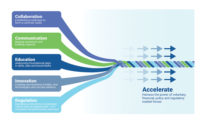Creators of the first U.S. campaign aimed at reducing embodied carbon in structural systems are issuing a call for engineers to join their crusade to help rid buildings of embodied carbon.
Last month at the virtual Greenbuild Conference, the Structural Engineering Institute of the American Society of Civil Engineers launched its EC reduction initiative, called the Structural Engineers 2050 Commitment Program. SE 2050 is the “first national program focused on structural engineering firm commitments to achieve net-zero EC structural system designs by 2050,” says Michael Gryniuk, chair of the SE 2050 subcommittee of SEI’s sustainability committee.
Measuring and reducing EC in structures is “an emerging field,” adds Gryniuk, an associate with LeMessurier Consultants. But “we do have the sense that the structure is the largest contributor of EC in a new building,” he says.
An office building structure can account for as much as 62% of the EC—45% for the superstructure and 17% for the substructure, according to S. C. Kaethner, of Arup, and J. A. Burridge, of the Concrete Centre, in Embodied CO2 of Structural Frames, in the May 2012 issue of The Structural Engineer. For a hospital or school, the total EC is about 51%, with 40% in the superstructure, say the authors.
SE 2050 Commitment Springs From SE 2050 Challenge
The SE 2050 Commitment has its beginnings in the SE 2050 Challenge, issued in September 2019 by the Carbon Leadership Forum. The challenge states: “All structural engineers shall understand, reduce and ultimately eliminate EC in their projects by 2050.”
Kate Simonen, CLF’s director, says the SE 2050 Challenge is analogous to the older Architecture 2030 Challenge and the SEI commitment program is analogous to the American Institute of Architects’ AIA 2030 program.
SEI's formal statement regarding SE 2050 is: "We, the Structural Engineering Institute of the American Society of Civil Engineers, support the vision and ambition of the SE 2050 Challenge. We, as a leading structural engineering organization in the U.S., recognize the need for coordinated action across our profession to achieve the globally stated goal of net zero carbon by 2050."
Getting to net-zero carbon in structures requires transforming the practice of structural engineering to be “holistic, firm-wide, project-based and data-driven,” according to SE2050.org. The intention is to educate about best practices of sustainable structural design and construction; establish appropriate EC reduction targets until net zero is realized; report on the current EC impacts and trends of various structural systems for different regions throughout the country; and make clients, the design community and the public aware of the benefits of EC reduction.
A Long Way to Go
The group has a long way to go to achieve its goals. To date, though membership is free, six firms have signed commitment letters and 425 firms have signed up for updates, says Megan Stringer, a subcommittee member and associate at Holmes Structures. Member firm names have not been released.
A beta-level SE 2050 EC database for building structural systems, except houses, to establish baselines, should be available this spring. SE 2050 is seeking funding to expand the database content, hopefully by the end of next year.
SE 2050 wants to set rational benchmarks based on quantitative analyses of real projects that could be used to establish aggressive yet realistic EC reduction targets or serve local and state jurisdictions trying to establish appropriate EC metrics.
“This data does not currently exist at a time when it is desperately needed,” Gryniuk says. “We hope to fill this void.”
Simple Structural EC Estimator Available
A tool available to help firms, whether or not SE 2050 members, is called the Embodied Carbon Order of Magnitude. ECOM is a simple estimator of industry average impacts of structural materials that allows a user to input basic quantities and a building area to output an order of magnitude EC impact.
ECOM, intended for structural concept analysis or to back-check results of a more thorough EC analysis, is based on environmental product declarations from the three major structural material groups—the National Ready Mixed Concrete Association (NRMCA), the American Institute of Steel Construction (AISC) and the American Wood Council (AWC).
NRMCA sees SE 2050 as a way to engage more directly with structural engineers, says Lionel LeMay, an NRMCA executive vice president. AISC and AWC also applaud the initiative.
SE 2050, developed with seed funding to date from SEI’s Futures Fund, also has published the first round of EC intensity diagrams—based on the EC of various framing schemes. “It’s our way of trying to inform the profession of typical EC impacts of concrete, steel and timber framing,” says Gryniuk. “We expect this will both inform as well as elicit some debate, which we consider good for moving the profession forward,” he adds.
Firms can join the SE 2050 program for free. But each must submit a commitment letter signed by its leadership. In addition, each member firm must submit an annual EC action plan, starting within six months of joining. And members must commit to submitting data to the database, within one year of joining and then annually.
Editor's Note: This article was updated on Dec. 7 to reflect new information.






Post a comment to this article
Report Abusive Comment